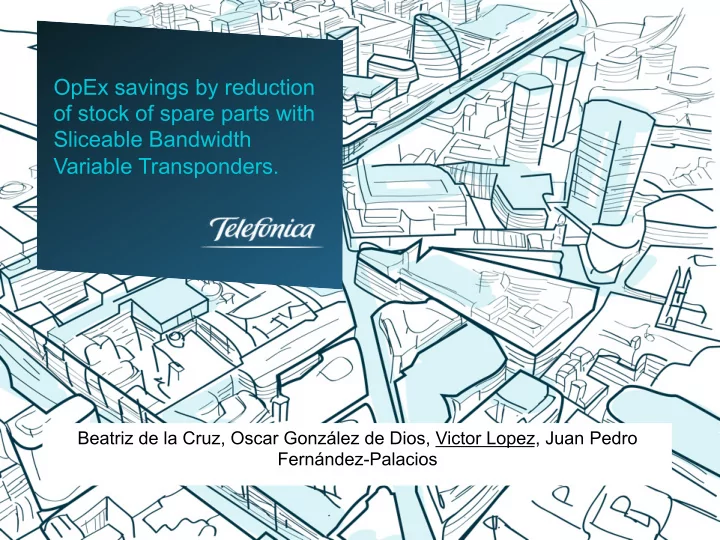

OpEx savings by reduction of stock of spare parts with Sliceable Bandwidth Variable Transponders. Beatriz de la Cruz, Oscar González de Dios, Victor Lopez, Juan Pedro Fernández-Palacios
Index Overview 01 SBVTs 02 Case Study 03 Results 04 05 Conclusions Core Networks Evolution 2 Telefónica I+D
01 Overview
Overview Stock Management Rationale The importance of having the suitable equipment at the right time. Reducing operational expenditures by an optimal stock study, based on Objective centralized model. • Minimum stock number required in order to keep the service. • Stock number for each kind of transponder Results • Percentage of time which a certain stock number keeps the service Expected Reducing expenditures related network maintenance and reparation increasing thus indirectly the benefits. benefits Core Networks Evolution 4 Telefónica I+D
Stock of spare parts with SBVT problem Problem definition. • Emerging technologies can help to deal with the ever-increasing demand: § Elastic Optical Network (EON). § Sliceable Bandwidth Variable Transponder (SBVT). • Different studies conclude SBVT allows a reduction in CAPEX. • Our work: quantify the reduction of network maintenance and reparation related OpEx by using SBVT. § Focused on cost related to keeping a stock of spare parts. • Stock of spare parts for replacement needs to be maintained in case of a failure in a network element. • Centralized stock model. • Analyze how equipping a network with Sliceable Bandwidth Variable Transponders instead of fixed rate transponders of multiple rates reduces the maintenance cost. Core Networks Evolution 5 Telefónica I+D
02 SBVTs
Current node structure without SBVTs • Node model for the study: Each line card needs a dedicated FW card of 40 or 100G switching capacity FW Card FW Card IP/MPLS Router Line Cards Chassis (including FW card) · · · IP/MPLS Tx Rx Tx Rx Transceiver SR Tx Rx Tx Rx Termninals Transceiver SR Tx Tx Rx Rx · · · WDM Transponders WDM Transponder Tx Rx Tx Rx A different WDM transponder per destination Core Networks Evolution 7 Telefónica I+D
Node structure with SBVTs • Node models for the study: FW card with higher switching capacity (i.e. 400Gbps, 1Tbps) IP/MPLS Router Line Cards Chassis FW Card IP/MPLS (including FW card) Tx / Rx Tx / Rx Ethernet Switch or OTN OTN framing Crossconnect added Limited Number of destinations S-BVT Transponder Tx/Rx Multiple Destinations Core Networks Evolution 8 Telefónica I+D
03 Case Study
Case Study • Spanish National Network: TR13 Scenario 1: Full Mesh Topology. § 2 12 Scenario 2: IP Top. Shortest path TR14 § 1 TR11 3 11 13 4 TR3 TR4 • IP nodes: TR1-TR14. 16 14 TR12 15 10 6 TR2 5 9 TR6 TR1 18 • Optical nodes: 1-30 8 17 7 20 TR5 Add/drop Node 25 26 19 • Each IP node is attached to an optical 27 OXC 21 TR10 22 node. TR7 28 TR9 23 29 • Studied cases: TR8 24 30 Case 1: Fixed traditional transponders. § Case 2: SBVTs. § Core Networks Evolution 10 Telefónica I+D
Procedure Generate random failures in time, based on Failures MTBF and following an exponential distribution. Get replacement information, knowing the necessary Replace ments time to replace one transponder. Stock counter: +1 if a fail happens, -1 if a replacement Stock happens. Obtain peak value à minimum stock number Results Achieve the percentage of time which a certain stock number keeps the service, knowing the peak value of minimum stock. Core Networks Evolution 11 Telefónica I+D
Input Data What is the required information? • Transponders: § Number of transponders § Fixed grid transponders: § Sliceable Bandwidth Variable Transponders § Cost Cost 40Gb/s, 2500km, 50 GHz 6 100Gb/s, 2000km, 50 GHz 15 • Time: 400Gb/s, 75GHz, 500km 22 § Reposition time à 3 months § Operational time à 10 years • Failures: § Mean Time Between Failures à 5 years Core Networks Evolution 12 Telefónica I+D
04 Results
Number of spare transponders Percentage of failures that can be repaired maintaining a certain number of spare transponders in a Full Mesh scenario for year 2014. Non-sliceable transponders SBVTs 100,5 100,5 100,0 100,0 99,5 99,5 40 Gbps (%) Availability 100 Gbps 99,0 99,0 99,999 % 400 Gbps (%) Availability (%) Availability 98,5 98,5 99,999 % 98,0 98,0 97,5 97,5 97,0 97,0 96,5 96,5 96,0 96,0 0 1 2 3 4 5 6 7 8 9 10 11 12 2 3 4 5 6 7 8 9 10 11 12 13 14 15 16 17 18 19 20 Number of Transponders Number of Transponders 30 Fixed Vs 9 SBVTs Lower number of spare transponders are necessary in the case of using SBVT to keep 99.999% availability. Core Networks Evolution 14 Telefónica I+D
Service availability from 2014 to 2020 Number of Stock required to keep 99.999% of availability v Full Mesh v IP Topology In both cases (Full mesh and IP) along the years higher number of total fixed, transponders are needed versus SBVT to keep 99.999% of availability. Core Networks Evolution 15 Telefónica I+D
SBVT Target Cost Full Mesh and IP Topology Target cost of SBVT to save 30% operational expenditures. • Possible cost of SBVT can vary between 22 and 30. 22 is the cost of 400Gbps fixed transponders § 30 imply an increase to 36% in the cost of the non sliceable § transponder. • The peak target cost value is reached in 2015 (12.5 Tbps) Core Networks Evolution 16 Telefónica I+D
05 Conclusions
Conclusions Summary of obtained results. • Operational Expenditures can be reduced base on the previous results obtained: § Lower number of spare transponders are necessary in the case of using SBVT to keep 99.999% availability § In both cases (Full mesh and IP) along the years higher number of total fixed keep being necessary versus SBVT. § Possible cost of SBVT can vary between 22 and 30 which implies an increase to 36% in the cost of the fixed transponder. Core Networks Evolution 18 Telefónica I+D
Core Networks Evolution 19 Telefónica I+D
Recommend
More recommend